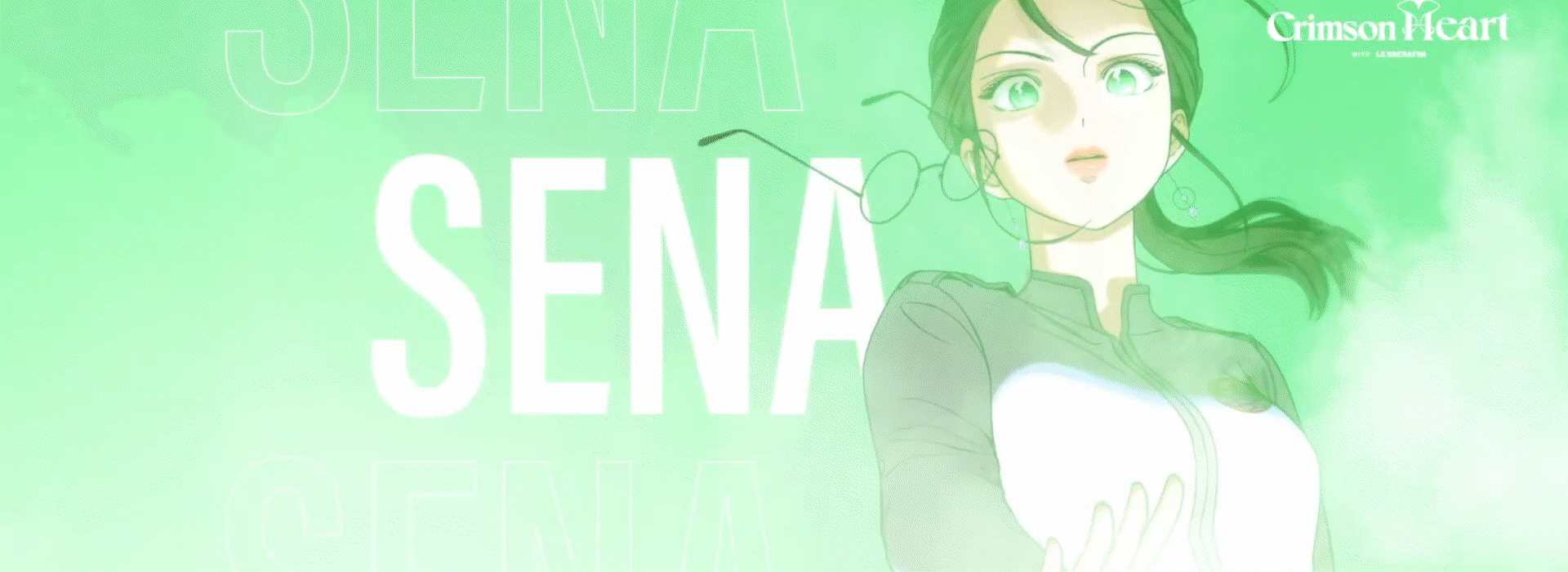
FEATURE
Crimson Heart, the Impermissible Adventure
The “Crimson Heart” Adventure Journey Written by Girls
2022.12.26
Credit
Article. Oh Minji
Photo Credit. Crimson Heart
“For the longest time, adventure was just for boys,” a representative for the Original Storytelling team explained. “They would leave home to find treasure or a new world, encountering challenges along the way, then return home to inherit the throne. But all the girls stayed within the boundaries that were set for them or couldn’t leave home at all. Today, though, girls have the ability to go anywhere they want and take on any adventure.” LE SSERAFIM’s new original story, Crimson Heart, is one such narrative revolving around today’s girls. Promotions for Crimson Heart have been designed to let people “really feel the independence of these women as they grow up and fearlessly go forth into adventure, not just see it on a surface level,” a representative from the Story Business Marketing team added. The girls in Crimson Heart venture out of Refugia, a safe but stiflingly uniform place, and into the Unknown. They set out to seek for the blue flame (desire) and start the adventure (“Blue Flame”), and admit that their ambitions and greed grow as they follow the necklace that shades as the greed grows; the “Crimson Heart,” and walk towards that desire (“Impurities”).
Throughout that process, the girls of Crimson Heart experience discomfort and conflict as can be expected when different people come together, but they eventually learn to rely on each other. The main characters have different backgrounds, personalities and abilities, and belong to different races. Joan (KIM CHAEWON) is weighed down by misplaced guilt and wants to be a better person. Sena (SAKURA) is a confident, natural leader and takes charge when others are in danger. Dabi (KAZUHA) has a knack for knowing where to go and is curious and cheerful. Looisha (HONG EUNCHAE) is half cat, half human, and is disarmingly cute. Yurina (HUH YUNJIN) grew up among magical but technologically stunted electric tribe and is both confident and full of open minded curiosity.
The characters in Crimson Heart share traits with the members who portray them. The girls in the story go through dissonance which naturally follows if different people become a team by fate. When the adventure begins, they hide details from each other about their powers and keep the Crimson Heart a secret despite it being key to helping them understand their situation. At other times, they find it hard to trust one another. They even come to doubt new friends’ existence. Despite all this, and though they have their own reasons for embarking on the adventure, the journey of heading towards the common goal is a tool that shows that the girls can face the new world without prejudice without having to fight, win or conquer. This idea of making friends with characters of different races is “so common in fantasy” and “we can understand people in our society who are from all different races, who are physically different or who have more complex backgrounds,” according to the Original Storytelling team rep, and in the story it carries a symbolic narrative that suggests we can grow stronger if we face the world without casting judgment. The girls possess unique backgrounds and personalities, but their adventure is an ongoing process of becoming friends by acknowledging and accepting the conflict between them and within themselves. As they say, “Alone we meander, but together we adventure!”
According to another rep from the Original Storytelling team, the story is “a fantasy that stretches to the very limits of imagination.” In the real world, we study for exams and look for jobs so we can go to school or work, only occasionally dreaming of something out of the ordinary, but in a fantasy like Crimson Heart, we can let our imaginations run wild and meet new people in strange new places. At the same time, the story is a metaphor for the real life we live in every day. According to another rep from the Story Business Marketing team, the story mainly takes place in Refugia, the Unknown and Blue Firefly Island, which symbolize “the girls’ worries about whether they can break through the limits of a city that’s tightly controlled, the process of coming to realize that there is another world out there and the ways they grow through everything they face.” It all figuratively points to an experience that everyone goes through at some point at least once: breaking away from the limitations of the small world that you came to believe is all there is in life and coming to embrace diversity as a result. Just as a child becomes an adult and enters the wider world, everyone who grows in some way will experience this same ritual.
At the same time, it was important to tell the story that reaches to the very furthest reaches of the imagination because it’s an adventure embarked on by a group of women. “Because women were forced to always be at home and seen as weak and in need of protection, it was difficult for them to have enough mobility to go out or rise to a high place,” the Original Storytelling team said. “But all women desire to venture out to distant places, too, and they can go exactly however far they want to. It was important that the limits of our imaginations be elevated to their absolute peak by both LE SSERAFIM and Crimson Heart reaching the highest and furthest places of their potential.” This, they explained, is the reason LE SSERAFIM and Crimson Heart both revolve around a world supportive of women’s mobility. For example, in the Crimson Heart tie-in promo video for “Blue Flame,” former Refugian Sena (SAKURA) watches a herd of sheep on a screen and Dabi (KAZUHA) is trapped under a glass dome that resembles a human eye. Both are being controlled by someone—domesticated in a world of uniformity like sheep, the first animal humans ever domesticated. But where the video really captures the spirit of Crimson Heart is when it shows Joan (KIM CHAEWON) leaving Refugia and looking back at the city from an outsider’s perspective, or when she’s joined on a hill with ex-Unknown residents Yurina (HUH JUNJIN) and Looisha (HONG EUNCHAE). Crimson Heart is the story of women who seek to climb ever higher in a world still shrouded in darkness—an adventure narrative revolving around women who move on even when they climb too high and fall, or go too far and become blinded.
While the story of Crimson Heart is just beginning, the characters have real-world parallels in the LE SSERAFIM members, and these idols have likely already experienced similar challenges and reached their own conclusions. Just as “the world brings out my flaws” and will “try to change” the idols (“The World Is My Oyster”), the girls of Crimson Heart will face similar obstacles. The song borrows its title from a line in Shakespeare’s comedy The Merry Wives of Windsor, where the character Pistol proclaims, “The world’s mine oyster, / Which I with sword will open.” Though the hard shell of the oyster (or world) makes it seem difficult to open, anyone with a sword can easily open it up, meaning it’s possible to get anything you want from the world—and just as an oyster shell often hides a pearl inside, the hidden treasure in the world is the self you find there. In the IRIDESCENT OPAL concept photos for ANTIFRAGILE, each of the LE SSERAFIM members is represented by a precious stone: for KIM CHAEWON, a diamond, which shines brilliantly after harsh cutting and polishing; SAKURA, the uniquely hard pink diamond with a pink fire inside; HUH YUNJIN, an emerald—beautiful, but extremely fragile, making it paradoxically highly valuable; KAZUHA, a sapphire, with its romantic image of the ocean that grows stronger each time the sea attempts to devour it with its dark complexion; and for EUNCHAE, a ruby, which mirrors the endless burning of aspiration. All are gems that can only be formed by enduring high heat and high pressure, and only shimmer if you’re not afraid to be cut and polished again and again as needed. In their documentary The World Is My Oyster, the members of LE SSERAFIM keep practicing through sweat and tears to reach the point where they can debut as a group. Likewise, the girls in Crimson Heart grow stronger as they continuously shape themselves without restrictions throughout the course of their journey and keep moving fearlessly forward. Only those who bear the pain and make it through the other side can confidently proclaim that “the world is my oyster.”
The protagonist in most adventure stories attains a kind of awakening precipitated by an experience of loss. They only reach a happy ending after suffering through self-sacrifice or the loss of someone close to them. LE SSERAFIM, however, are the face of women reaching a happy ending without having to sacrifice anything. Their song “The Great Mermaid” references “The Little Mermaid,” a fairytale in which a mermaid saves and falls in love with a prince and sacrifices her own voice in order to gain legs, but she can’t win the prince’s heart and finally returns to the ocean as sea foam. But even in a world where it’s generally believed you have to “give up one thing to gain another,” LE SSERAFIM refuses to give up their voices, singing that they “don’t wanna sacrifice” and telling the listener that they should try to get everything they want because if you don’t give up you’ll eventually find truth (“The Great Mermaid”). For the Little Mermaid, her voice is more than just a means of speaking and singing—it’s the only way to show she’s there and to speak about the truth and her feelings. People like her think that to dream of happiness is to lose the things you value most and to even lose yourself. The Great Mermaid doesn’t give up the things she values and she lives for the sake of her own happiness, even if it could lead to “the world” being “submerged in my sea” and everyone drowning. Similarly, the song “Sour Grapes” inherits its title from the well-known line in the fable “The Fox and the Grapes” when a fox, finding itself unable to obtain the grapes it wants to eat, justifies the loss by saying the grapes are likely sour to begin with. LE SSERAFIM likens love to sour grapes when, “even though I step up one by one” up a ladder in fear, “I can’t hold your hand.” They have no interest in finding love that risks a fall and they refuse to eat sour grapes. They do not make sacrifices, nor do they sacrifice others, and by making only the choices that work best for them, they bring about their own happy and fulfilling ending without having to crawl to a finish line while weighed down by despair. If the purpose of a fairytale is to teach a lesson to children, what kind of choices will the children who grow up listening to LE SSERAFIM and following their journey make, and what sort of endings will they ensure for themselves?
LE SSERAFIM’s group journey and their original story Crimson Heart are narratives created by “women who decide for themselves how each of their stories begin and end and keep pushing boundaries,” according to the Story Business marketing team. Crimson Heart is an interpretation of the LE SSERAFIM members’ real-life experiences in the form of a fantasy narrative where characters face every challenge in their lives without fear. Just like the real people they’re modeled after, the characters in the adventure story welcome people different from themselves, yearn for higher and more distant places and come out of every fall soaring through the sky. It’s the kind of story that was once forbidden, but now it wouldn’t feel right any other way.

wattpad

Crimson Heart
Web novel

WEBTOON

Crimson Heart
Webtoon

Weverse Shop

LESSERAFIM 2nd Mini Album ‘ANTIFRAGILE’
Copyright © Weverse Magazine. All rights reserved.
Unauthorized reproduction and distribution prohibited.
Unauthorized reproduction and distribution prohibited.
